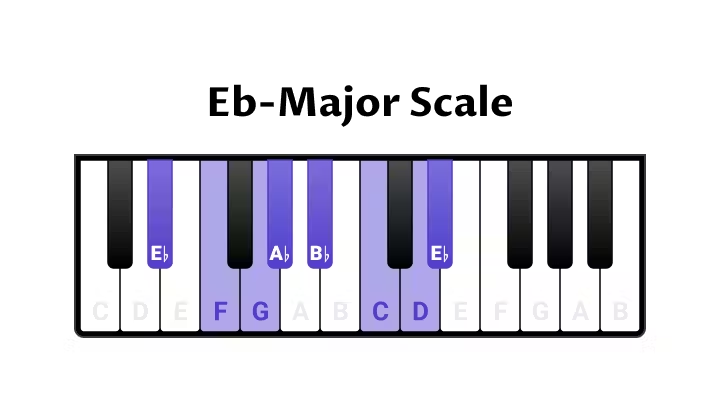How to Play the E-flat Major Scale on the Piano - Scales, Chords & Exercises
Jump to section
You get a fascinating chord poster + exclusive content!

What Are the Notes of the E-flat Major Scale?
The E-flat Major scale starts on Eb and includes three flats: Eb, Ab, and Bb. It uses the notes Eb-F-G-Ab-Bb-C-D-Eb. On the piano, you need to play three black keys: Eb, Ab, and Bb. For all of the other keys, you can use the white keys.


How to Play the E-flat Major Scale With the Right Hand (Treble Clef)
On the piano, you can play any scale going up (toward the higher notes), or coming down. The fingering is almost, but not quite, the same as the Bb Major fingering.
- Play the following notes going up in the treble clef: Eb-F-G-Ab-Bb-C-D-Eb. Start playing with your 3rd finger on the Eb, and after you have played the Bb with your fourth finger, tuck your thumb to reach the C. Then continue up, ending on Eb with your third finger. To help orientation, think of playing the first note, then a block of 4 fingers, then a block of three.
- Play the following notes going down: Eb-D-C-Bb-Ab-G-F-Eb. Go down inversing the exact way you have played coming up: Start playing with your third finger. After the thumb has played the C, tuck your fourth finger over the thumb to play the Bb, and continue until your first finger reaches the F, then tuck your third finger over to play the Eb.

How to Play the E-flat Major scale with the left hand (bass clef)
Piano beginners may find it difficult to read and play the left hand. It is worth investing some time to really familiarize yourself with the notes of the Eb-Major scale in the bass clef, and learn how to read them in music scores.
The notes are the same in both clefs, treble, and bass, Eb-F-G-Ab-Bb-C-D-Eb, but they look different:

The way you play the scale and the fingering is nearly the same as for the right hand.
- Going up: Start with the third finger, then use the second and first finger to reach the G. Tuck your fourth finger over to reach the Ab, then play up until you reach the D with your first finger. Finally, tuck your third finger over to end on Eb.
- Coming down: Simply reverse what you've just done - start out on Eb with your third finger, tuck your thumb under to play the D, then play down until your fourth finger reaches the Ab. Tuck again to reach the G with your thumb, and finish with your third finger on Eb.
The E-flat Major Key Signature
The key signature, located at the beginning of each line of a piece, lets you see which notes will be raised (#) or lowered (b) consistently throughout that piece.
If you spot this key signature below it is very likely that the piece is in Eb-Major (or in C-minor, the parallel minor scale:

6 Exercises to Practice the E-flat Major Scale
Play one exercise after the other and only move on after having correctly played the previous exercise 5 times on your piano:
- Play the left hand up and down using a metronome and slowly increasing speed
- Play the right hand up and down using a metronome and slowly increasing speed
- Play both hands up and down using a metronome and slowly increasing speed - this one is NOT easy, so take your time!
- Play the left hand up starting from the lowest Eb to the highest, and down starting from the highest Eb to the lowest
- Play the right hand up starting from the lowest Eb to the highest, and down starting from the highest Eb to the lowest
- Play both hands up starting with the left hand on the lowest Eb and stopping when the right hand reaches the highest Eb, then play down to the starting position
Why you should exercise scales in general:
- To memorize a scale
- To practice dexterity and intonation (play all keys with even loudness. Beginners often play the notes they work with their stronger fingers much harder. Aim for an even tone)
- To be able to play the scale in time without hesitating to find your fingerings
- To be able to build chords and improvise
E-flat Major Chords on the Piano
A chord is constructed of three or more notes: The root note - the major third - the perfect fifth.
Briefly explained for E-flat Major:
- The basic Eb Major chord consists of Eb-G-Bb.
- The first inversion is G-Bb-Eb.
- The second inversion is Bb-Eb-G.
To practice the chord and its inversions, switch from the chord starting with the root note to the first, and the second inversion, starting slowly using a metronome, then increasing your tempo.
Top Pieces in E-flat Major for All Skill Levels
- 1 La Dispute: Yann Tiersen
- 2 Room With A View: Yiruma
- 3 You Raise Me Up: Josh Groban
- 4 Nocturne in E-flat Major, Op. 9 No. 2: Frédéric Chopin
- 5 Your Song: Elton John
- 6 Over The Rainbow: Harold Arlen
- 7 Fix You: Coldplay
- 8 What A Wonderful World: Louis Armstrong
- 9 You've Got A Friend In Me: Randy Newman


